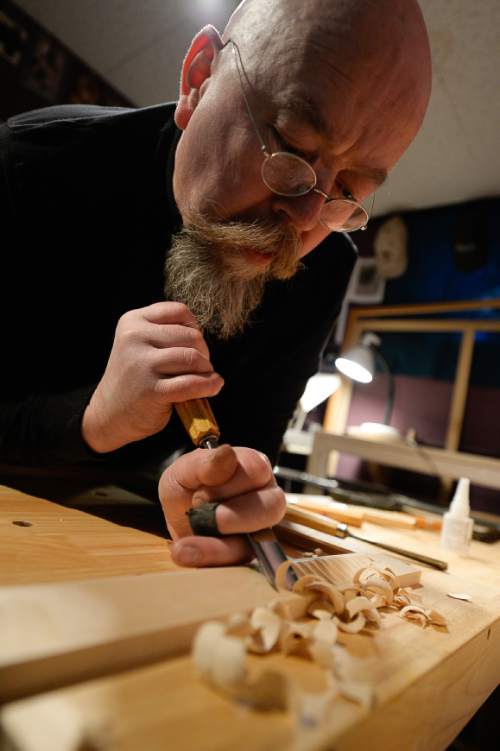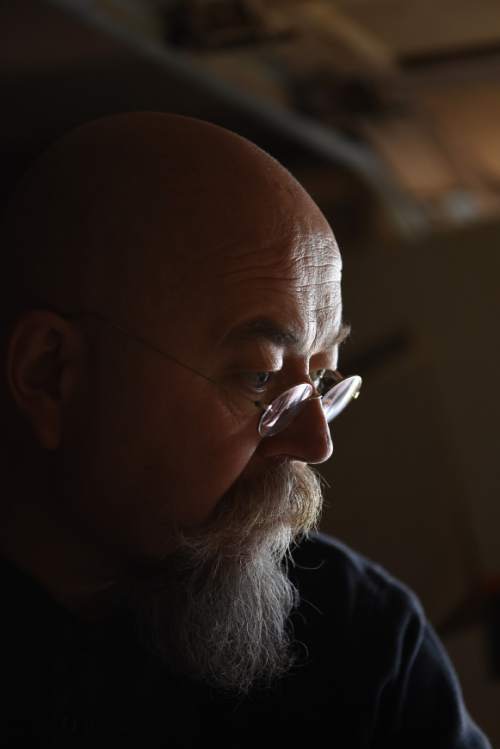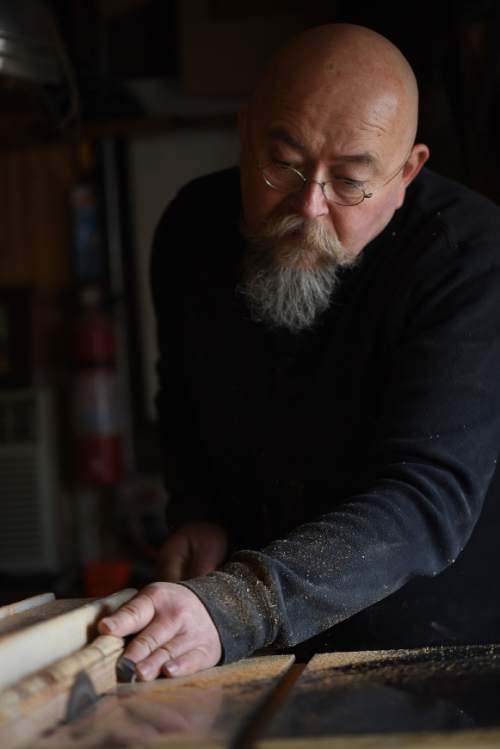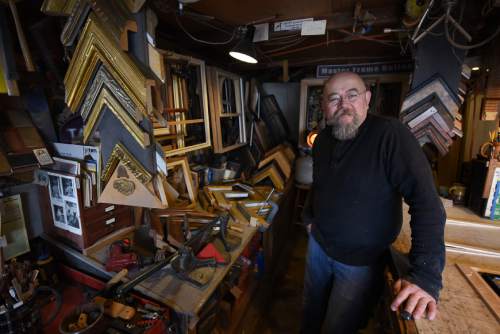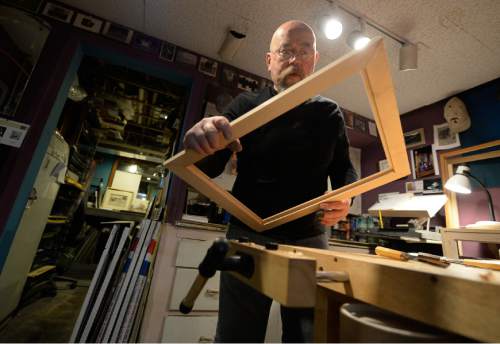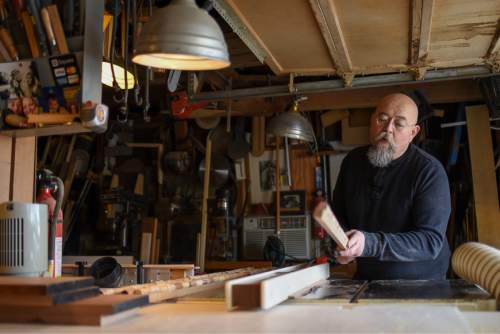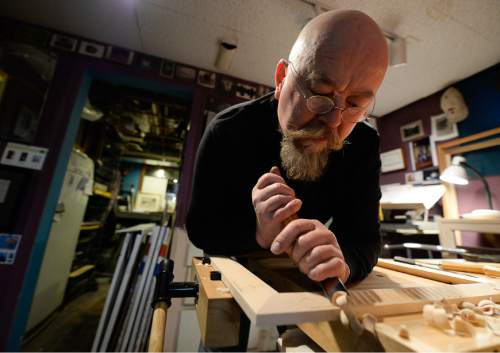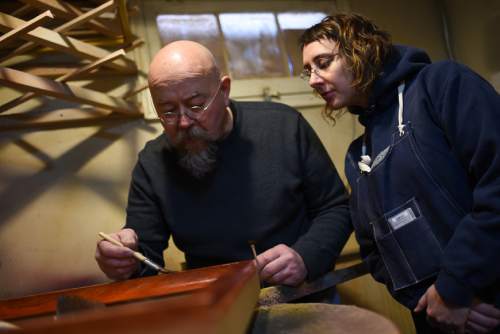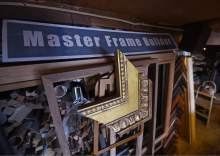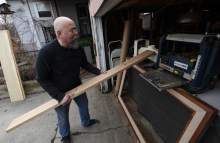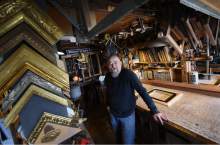This is an archived article that was published on sltrib.com in 2016, and information in the article may be outdated. It is provided only for personal research purposes and may not be reprinted.
Fine-art framer Scott Gardner twice refused Adrienne C. B. Winter's request to become his apprentice, and each time, she waited two weeks to ask again.
Finally, she told him, "Look, if you're going to teach anyone, ever, it's me. I need you to teach me. There's nobody else."
Her reward: eight hours every Sunday for five years — unpaid — crafting artisan frames alongside Gardner in his Millcreek home.
Gardner founded his unique business in 1983, naming it The Second Artist at a suggestion of a friend who told him a "second artist" was the top student of a Renaissance master, tasked with finishing, framing and delivering a piece.
He begins with raw lumber — bought locally, if possible — and mills the wood in his pink one-car garage.
Gardner carves using unassuming but pricey hand tools and mixes his own pigments, bases and solvents. His frames are finished after they're joined, making them more durable than mass-produced frames — with no visible miters — and sealed by multiple coats of pigmented shellac that protect the artwork.
Though he's capable of producing a range of frame styles, he's most known for his traditional application of gold leaf through a process known as water gilding.
He's not particularly fast. Utah art dealer Dave Ericson works with another custom framer who can make something in a day, if need be, while Gardner's average turnaround is one to three months. But to find Gardner's equal in gold leafing, Ericson said, you'd have to visit pricier operations in Los Angeles, Denver or Santa Fe, N.M.
Gardner is a sturdy man with round, rimless glasses and an artful goatee, his searching eyes supporting his claim that he's committed to understanding a customer's intent and not making his own bold statements.
His mother was a "Sunday painter," a woman fond of sweet mountain meadow scenes that he calls "Upper East Bench lovely," while his optician father was miffed that Gardner was the only one of his five children never to work for him. Rather, Gardner said, he chose to "live in the art room" at Olympus High.
Two months after he completed a mission in London for The Church of Jesus Christ of Latter-day Saints, Gardner returned to England to marry a woman he'd met while serving. He worked illegally, picking strawberries, before landing an aboveboard job from 1975 to 1979 as an apprentice to a woodworker.
When he moved back to Utah with his wife and their three children, he failed to find work as an artist or photographer, so a friend suggested he try framing.
Gardner plied the trade at two frame shops before buying a space from Utah photographer Dave Newman on Highland Drive and later mastering gold leafing through studies in Santa Fe.
His frames became sought after by, among others, the LDS Church History Museum, despite Gardner's skepticism that they knowingly would employ a self-described "Jack Mormon."
(The museum's art director assured him that at his level of skill, he was as close to doctrinal as they were likely to get.)
But Salt Lake City isn't exactly a fine-art hub, and demand for Gardner's work has ebbed at times. He's worked at Woodcraft in Sandy to supplement his income.
A fire at the Highland shop led him to move his business into his home about five years ago, and after a divorce, "I've taken over the whole damn house," he said.
He isn't keen on discussing his workspace, or what it says about his devotion to framing that half of his house is dedicated to its various stages.
He may feel, Winter said, that people will consider his business less legitimate for its lack of a separate brick-and-mortar presence.
But they might also marvel at his efficiency.
Entering his garage mill you are greeted by a display of corner samples, with trade publications and sketchbooks filed orderly upon shelves and lumber stacked so the aisle around the workbench is clear, if cozy.
From there, the pieces are brought into his house, passing his two excitable dogs on the way to the basement, where the dogs know not to venture.
Down the stairs are four tidy spaces, each with a purpose. One room is Gardner's "assembly hall," for joining pieces with vises and clamps. There's another for carving, another for fitting and another for finishing — with an extractor fan by the ground-level window to vent chemicals.
"He has it down to the centimeter, how big a frame he can produce in his basement and still get it out of his door," said Winter, the apprentice, who was accustomed to working in a large commercial space.
Gardner is proud that his frames are "archival," and they might last hundreds of years without damaging the art.
But he has had to accept that his own work will cease much sooner than he intended.
Gardner developed a tremor in his right hand about 10 years ago.
Up until about a year ago, medication stopped the shaking, though it made him sleepy. Now, the hand trembles constantly.
It isn't related to Parkinson's disease, but the only lasting fix is deep brain surgery that isn't covered by his insurance, he said.
He can still carve, and handle a saw or router. But he's come to rely on Winter, who also works in a commercial frame shop full time and paints, when a task requires a steady hand.
The application of gold leaf — many times thinner than a sheet of paper — is one such task.
"It almost feels like it's going to fall to dust at any moment," Winter said.
Though he was a tough sell on Winter's partnership, Gardner hopes to impart to her all that he knows. They've had to be patient with each other. Some Sundays, when she's ready to leave at 4:30 p.m. and rest for her day job, "he's like, 'Nope,' " she laughed.
It takes time to create something lasting.
Twitter: @matthew_piper


